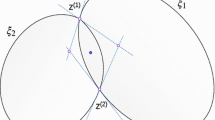Abstract
We continue the investigation of the problem of construction of a minimum-area ellipse for a given convex polygon (this problem is solved for a rectangle and a trapezoid). For an arbitrary polygon, we prove that, in the case where the boundary of the minimum-area ellipse has exactly four or five common points with the polygon, this ellipse is the minimum-area ellipse for the quadrangles and pentagons formed by these common points.
Similar content being viewed by others
References
B. V. Rublev and Yu. I. Petunin, “Minimum-area ellipse containing a finite set of points. I,” Ukr. Mat. Zh., 50, No. 7, 980–988 (1998).
W. Blaschke, Kreis und Kugel, Walter de Gruyter, Berlin (1956).
Author information
Authors and Affiliations
Additional information
Translated from Ukrainskii Matematicheskii Zhurnal, Vol.50, No.8, pp. 1098–1105, August, 1998.
Rights and permissions
About this article
Cite this article
Rublev, B.V., Petunin, Y.I. Minimum-Area ellipse containing a finite set of points. II. Ukr Math J 50, 1253–1261 (1998). https://doi.org/10.1007/BF02513081
Received:
Issue Date:
DOI: https://doi.org/10.1007/BF02513081




